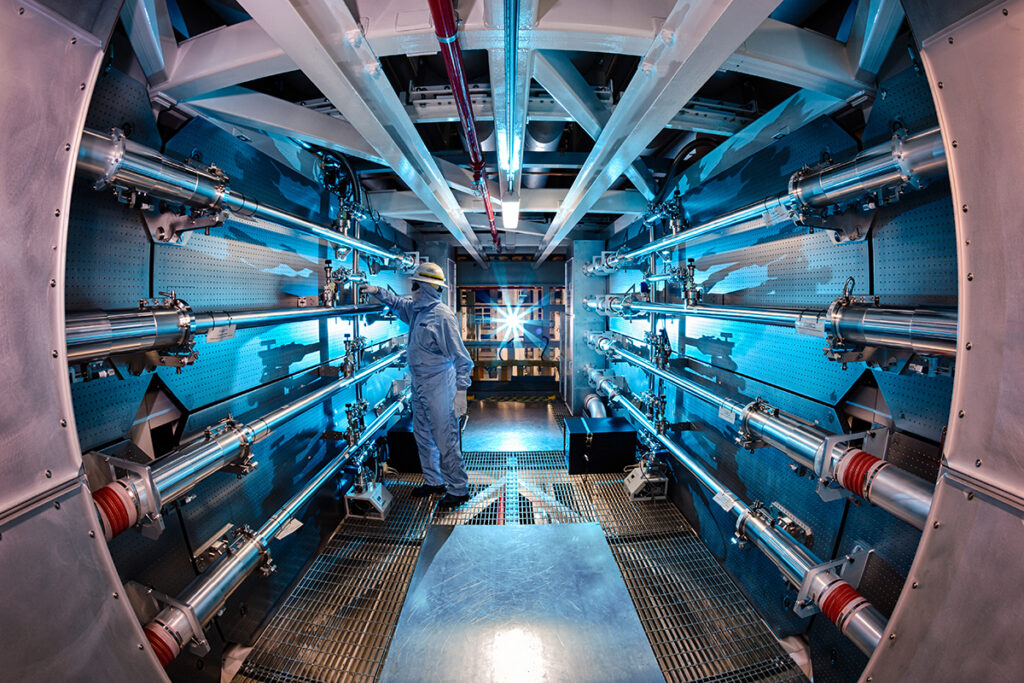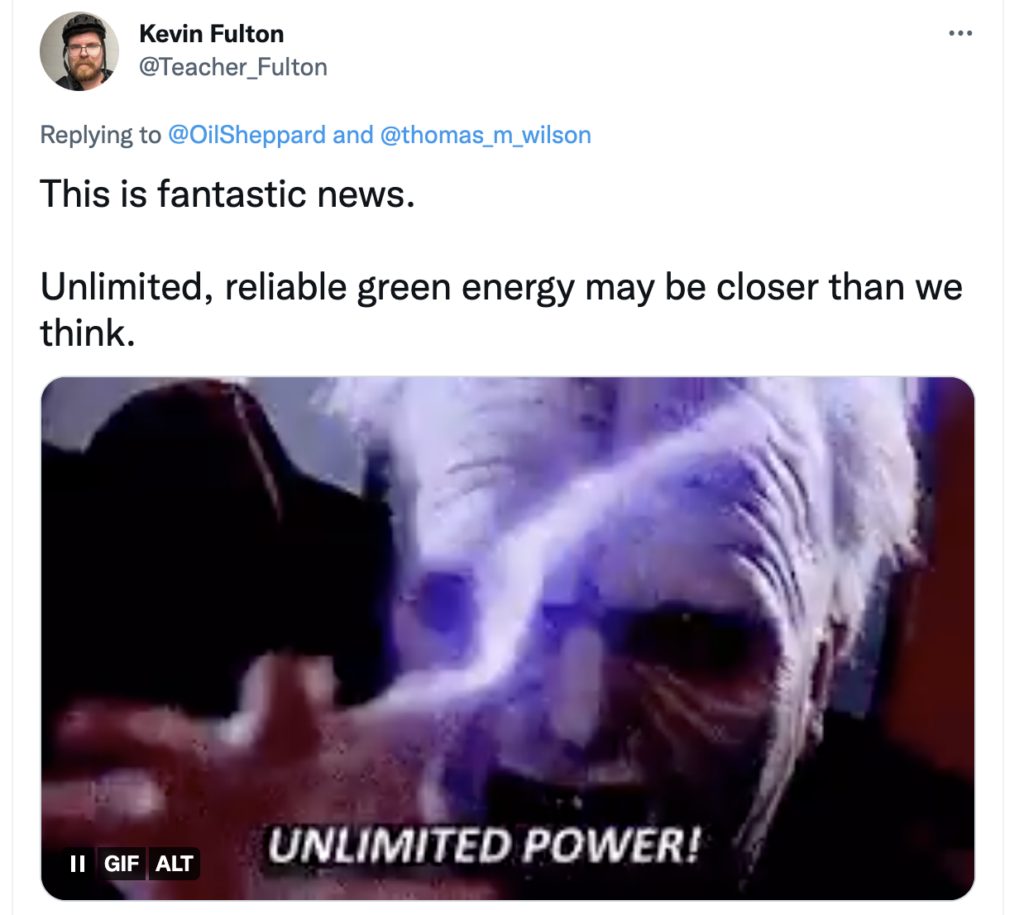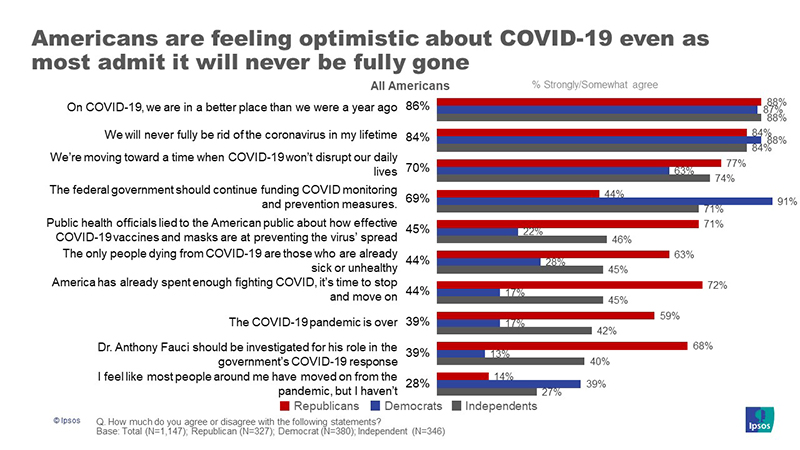Volcanoes are erupting in The Philippines, but on-fire Australia received some welcome rain. The Iran war cries have been called off and The Donald’s military powers are about to be hamstrung by the Senate. Meanwhile, his impeachment trial is starting, and we’re all on Twitter for a front-row seat.
What Could Go Right? Nuclear fusion breakthrough!
Why the fusion news is significant, although far from an immediate climate fix.
This is our weekly newsletter, What Could Go Right? Sign up here to receive it in your inbox every Thursday at 6am ET. You can read past issues here.

Nuclear fusion breakthrough!
On Tuesday researchers from the National Ignition Facility at the Lawrence Livermore National Laboratory in California confirmed that for the first time, they have produced a fusion reaction that resulted in a net energy gain, a major breakthrough in the pursuit of nuclear fusion power.
When we talk about nuclear power, we’re usually talking about nuclear fission, which splits atoms to create energy. You’ll recognize the radioactive waste it produces as the usual subject of controversy when it comes to discussions around nuclear. The other type of nuclear power is nuclear fusion, which combines atoms to create energy. Nuclear fusion is how the sun powers itself, and humans have been trying to make it happen here on our planet since the 1950s. As many outlets have explained this week, producing energy using nuclear fusion is a tantalizing possibility because it has virtually no waste and no carbon footprint.
So far, the various laboratories around the world going after nuclear fusion haven’t managed to produce more energy than used to create the reaction—until now. This is what is meant as “net energy gain,” and the fact that a team has accomplished it is a significant development, even if the amount of gain was small—enough to boil 15–20 kettles of water.
We’re still a long ways away from the dream of using nuclear fusion power, though. The term “net energy gain” is correct but can also be misleading. What “net energy gain” is referring to in this instance is what scientists call “Q plasma,” meaning that more energy came out of the plasma than came in. In the case of the Livermore laboratory in particular, which uses a nuclear fusion method that involves shooting lasers at pellets of hydrogen plasma, more energy came out of the pellets/plasma than was put in by the lasers.
But that “Q plasma” doesn’t account for the system-wide energy use; in other words, how much energy is required to fire the lasers, and, if you’re talking about eventually using nuclear fusion energy for electricity generation, the loss of energy that occurs when the produced heat from the fusion reaction gets converted into electric power. That Q is called “Q total,” and that’s the really big one when it comes to nuclear fusion as a realistic power source. German theoretical physicist Sabine Hossenfelder has a clear, 10-minute YouTube video here explaining the two Qs.

In the work by the Livermore laboratory, when it came to Q total, they were far off the mark, using much more energy overall than was created by the fusion reaction. That’s why, though this news is definitely a breakthrough, we’re still quite a ways off from commercial viability when it comes to nuclear fusion power. Another way to think about it is as the difference between scientific versus engineering viability, as Dennis Whyte, director of the Plasma Science and Fusion Center at MIT, told The Washington Post. We’ve got scientific viability now for the first time. It’s unclear how long it will take to get to engineering viability.
For more, The Washington Post has a solid overall explainer here, and The Atlantic spells out just how far we are from engineering viability here. If you’re pressed for time or hitting paywalls, try this short Twitter thread here, although we found the longer articles more easily understandable.
Still, as The Atlantic piece argues and as we are wont to do at The Progress Network (TPN), we can choose to feel excited about the possibilities of nuclear fusion power while being sober-minded about the timeline. We don’t know if nuclear fusion power will happen soon, if ever. Such long-term science seems tough to cheer on when we have so many immediate problems at hand. But a society that goes after daring, seemingly impossible things is necessary for the kind of eventual progress we laud all the time here in this newsletter. As TPN Member James Pethokoukis (hilariously) wrote in the Faster, Please! newsletter, “Let’s light this nuclear fusion candle!”
Before we go
Speaking of what science and engineering can accomplish, the 2022 roundups continue. Here’s The Atlantic’s Derek Thompson on the breakthroughs of the year, most of which we covered in this newsletter. And here are the best engineering feats from Popular Science. One follow-up on the pig-to-human heart transplant that Thompson mentions in his list and that happened at the top of 2022: scientists are getting closer to identifying what went wrong. The patient died two months following the heart transplant, potentially due to a common pig virus in the heart that was missed in a pre-surgery screening. MIT Technology Review has the story.
It’s time to exit the school of thought that says that governments, corporations, and humans generally are doing nothing when it comes to the climate. Reporter for Inside Climate News Dan Gearino wrote, “This has been the most eventful year in my decade-plus of covering energy.” Check out his roundup from an “extraordinary year of action and progress at the federal, state and local levels” here. By the way, we spoke to TPN Member Bina Venkataraman about American climate action for the last episode of the What Could Go Right? podcast season. We’ll be back in early 2023 for Season 4.
College freshman—and small-town mayor. Congratulations to 18-year-old Jaylen Smith, the youngest Black mayor in US history, who beat out his opponent by 79 votes to become the next mayor of Earle, Arkansas.
Electric bikes: their silent motors may mean you get mowed down on the street corner. But they also allow park rangers in Mozambique to sneak up on poachers undetected. Before, the loud petrol motors were a dead giveaway that the rangers were approaching, and the poachers would flee. Take that, antelope killers! We absolutely adore this article on the Swedish e-bikes that have changed the game when it comes to stopping poaching in 127 parks across Africa.
Below in the links section, heat- and drought-resistant wheat, psychedelic therapy as a workplace perk, a “vagina on a chip,” and more.

Misinformation, climate momentum, and negative headlines | S3 E12

This week on the What Could Go Right? podcast: Is there a shift in momentum around the climate crisis? Will we ever hit our environmental goals? How has gatekeeping and bias informed our news? Plus, we talk with Editor-at-Large for The Boston Globe and former Senior Advisor for Climate Change Innovation in the Obama White House, Bina Venkataraman. | Listen to the episode
Progress, Please
(Found good news? Tweet at us @progressntwrk or email.)
Other good stuff in the news 🌕
Energy & Environment:
- Will we ever be able to recycle our clothes like an aluminum can? | The New York Times
- Renewables to overtake coal and become world’s biggest source of electricity generation by 2025, IEA says | CNBC
- New food technologies could release 80% of the world’s farmland back to nature | The Conversation
- Jabal: the new wheat scientists say can withstand extreme heat and drought | The Guardian
- Roadside solar fields across the US could power up to 12 million electric vehicles | Grist
- Clouds may be less climate-sensitive than assumed | Phys.org
- World’s first solar city car is coming to the US for $6,250 | EcoWatch
- Wolf population set to expand in California and Colorado | The Hill
Science & Tech:
- Psychology and science get a new way to detect bad research | Vox
- “Korean Google” opens the world’s first robot-friendly building | Freethink
- NASA invests $57 million in a 3D laser printer to build moon bases | Freethink
- Experimental CRISPR technique has promise against aggressive leukemia | New Scientist
Politics & Policy:
- Colorado aims for 100% EVs with no gasoline bans | E&E News
- Five ways the Biden DOE is spending big on nuclear energy | The Hill
- More US cities are excelling at policies on LGBTQ equality even amid hostile legislation, report finds | USA Today
- EU agrees to a new law to kick deforestation out of supply chains | Euractiv
- How Houston halved homelessness—and what California can learn from it | The Nation
- A new law will require employers to post job salary ranges in Washington | Axios
Public Health:
- Psychedelic therapy is moving to the next frontier: workplace perk | STAT
- Major obesity advance takes out targeted fat depots anywhere in the body | New Atlas
- The US unveils a new system to track and better prevent opioid overdoses | NPR
- Scientists have designed a ‘vagina on a chip’ | The New York Times
- Affordable Care Act enrollment is up 18% year over year to 5.5M so far | Fierce Healthcare
- FDA clears updated Covid booster shots for kids under 5 | NBC News
- Dermatologists call out gap in medical training for patients of color | USA Today
- AI and robots could help detect urinary tract infections earlier | The Washington Post
Society & Culture:
- Poll: Americans will spend more to support companies that have a reputation for doing good | The Hill
- Families wanted a Black Santa, so one man created a company to provide them | NPR
- The curriculum wars in the US are based on an illusion | Persuasion
Economy:
- Ohio workers voted for union at GM, LG battery plant | Reuters
TPN Member originals 🧠
(Who are our Members? Get to know them.)
- Why young people should resist being cynical about the world | Emma Varvaloucas
- How to be anti-tribal with Mónica Guzmán | Robert Wright
- What is fascism? | Ruth Ben-Ghiat
- 2076 or bust: What will the US and world look like on America’s Tricentennial? | James Pethokoukis
- The fastest way to get over a breakup and grow | Arthur C. Brooks
- World Energy Outlook 2022: An insider’s look | Jason Bordoff
- How Biden can help save the Middle East | Thomas L. Friedman
- Value-based businesses | Nicholas Thompson
- Ranked-choice voting in 2024? | Andrew Yang
- Smashing the stigma surrounding aging | Ashton Applewhite
- ChatGPT could make democracy even more messy | Tyler Cowen
- On that ProPublica ‘Chinese lab leak’ story | James Fallows
- More questions for ProPublica on their gravely flawed lab leak article | James Fallows
- Inflation, recession signals, and the housing market | Scott Galloway
- Amtrak should build a good train | Matthew Yglesias
- American protectionism could imperil a golden era of Western unity | Fareed Zakaria
- The tragedy of Herschel Walker isn’t over yet | Peniel E. Joseph
- Ben Rhodes on where American foreign policy went wrong | Yascha Mounk
Department of Ideas 💡
(A staff recommendation guaranteed to give your brain some food for thought.)
The Twitter Files and the sinister label of “misinformation” | Hold That Thought
Why we picked it: The release of the “Twitter Files” makes the social media company’s suppression of accounts and information public knowledge. This transparency moves us forward, and it should discourage us from labeling as “misinformation” what is merely disagreement and plain old discussion. —Brian Leli
Until Next Time
BREAKING: Turns out kids today have been spoiled for over 100 years already. 👇


